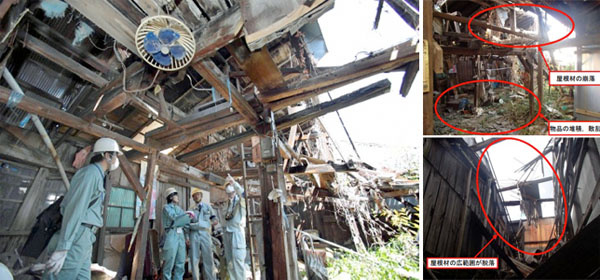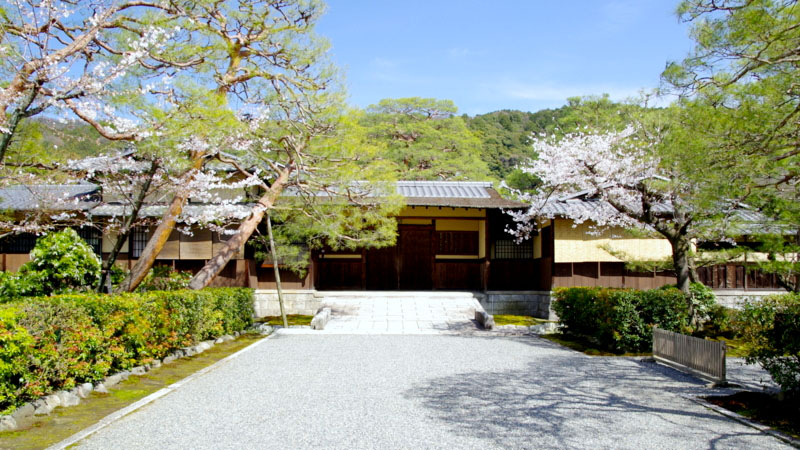Kyoto carries out first forced demolition

On April 30, Kyoto City began procedures to carry out a forced demolition of an abandoned house in Kamigyo-ku. This is the first case of a forced demolition to be carried out by proxy by the city.
The single-storey wooden structure, which was over 65 years old, was at the brink of collapse. It had once been a house with a workshop space that was used for the production of Nishijin-ori textiles. There were two owners listed on the property title, one of whom had since died, and another who could not be contacted.Read more
Kyoto’s machiya revival
The traditional wooden merchant houses (machiya) lining the streets in Kyoto are a defining part of the historic city’s atmosphere. Yet, over 5,000 of these machiya are vacant, and approximately 2% of them are demolished each year.
Some of these homes are being converted into guesthouses and have been very popular with foreign visitors.Read more
Nanzen-ji: Japan’s most expensive and exclusive residential area

London has Kensington Palace Gardens, Hong Kong has Pollock’s Path and Monaco has Avenue Princesse Grace. Japan’s most expensive and most exclusive neighbourhood is not in Tokyo, but in the grounds of a temple in the historic former capital of Kyoto.
Nanzen-ji is a Zen Buddhist temple that was first established in 1291 by Emperor Kameyama on the site of one of his former palaces. During the anti-Buddhist movement at the beginning of the Meiji Restoration, Nanzen-ji’s grounds and sub temples were seized by the government, subdivided and sold off to private interests. Between the Meiji period and early Showa period, Japanese nobility began to build luxurious holiday homes with expansive and carefully designed Japanese gardens.
Competition amongst the elite was strong, with each one trying to build a bigger and grander villa than the other. Today, 15 of the original villas remain. Many of these villas are still owned by descendants of the original owners, or are held by some of Japan’s top companies and are not open to the public. These estates are worth as much as 100 million USD, but are so tightly held that, no matter how much money you may have, the area cannot be bought into at any price.Read more
Apartments to be built in historic Kyoto Shrine grounds

Shimogamo Shrine in Kyoto’s Sakyo Ward announced that several condominiums will be built on part of the shrine’s grounds.
The shrine’s main buildings are rebuilt every 21 years. To help raise the 3 billion Yen required to rebuild in 2015, part of the shrine’s land will be leased to a private developer. The shrine has already raised 1 billion Yen and will receive around 800 million Yen in national grants.
A 9,650 sqm parcel of land about 600 meters south of the main shrine will be leased to a private developer under a 50-year term with an annual land rent of 80 million Yen. At the end of the lease, the buildings will be demolished and the land will be returned to the Shrine. The land is currently used as a car park and training hall.Read more
Luxury apartment boom in Kyoto fuelled by Tokyo buyers
Kyoto is seeing a renewed interest from wealthy buyers looking for luxury holiday homes. A number of high-end condominiums in central Kyoto have been selling out quickly due to demand from Tokyo residents. The historic city, which is an admired and world-renowned tourist destination, is additionally appealing as its real estate prices are relatively cheap when compared to Tokyo. Supply is also limited due to to various height restrictions and a shortage in available development sites.
The area inside Oike, Gojo, Kawaramachi and Horikawa Streets has seen the recent development of several luxury apartments.

Nomura Real Estate’s ‘Proud Kyoto Fuyacho Oike’ is currently under construction alongside Oike Dori Avenue and 200 meters from Kyoto City Hall. Apartments went on sale in December 2014 and the 43 units received 83 purchase applications (lucky buyers were selected from a raffle). The two, three and four bedroom apartments ranged in size from 67 ~ 104 sqm (721 ~ 1,119 sq ft) and were priced from 60 ~ 140 million Yen. 80 sqm apartments were priced in the 80 million Yen (670,000 USD) range. Apartments are scheduled for delivery from the end of March 2016.Read more
Apartment price to income ratio worsens nationwide, but improves in Tokyo and Osaka

According to Tokyo Kantei, the average price of a brand new apartment in Japan in 2013 was 6.59 times the average annual income (up 0.06 points fro 2012), while a second-hand apartment (10 years old) was 4.58 times times the average income (up 0.02 points from 2012).
The rise in apartment prices has outpaced the increase in average income. The average annual income across Japan increased by 3.85% from the previous year to 4,320,000 Yen in 2013.
Meanwile, the average price of a 70 sqm second-hand apartment in Japan was 19,800,000 Yen in 2013, up 4.38%. The average price of a brand-new apartment nationwide was 28,620,000 Yen, up 5.07% from the year before.
In greater Tokyo (Tokyo, Kanagawa, Saitama and Chiba Prefectures), the price-to-income ratio of brand new apartments was 8.80 times (+0.06 points). The ratio for second-hand apartments actually fell 0.05 points to 6.07 times. Read more
Kyoto looking for tenant for historic restaurant/ryokan in Gion
 Kyoto City is looking for a tenant for a traditional-style residence/restaurant in the Gion-shinbashi neighbourhood. The 2-storey wooden house was during the Meiji period and is estimated to be around 120 years old.
Kyoto City is looking for a tenant for a traditional-style residence/restaurant in the Gion-shinbashi neighbourhood. The 2-storey wooden house was during the Meiji period and is estimated to be around 120 years old.
Until recently it was used as a tempura restaurant. The owner of the property and former operator of the restaurant left the property to the city in June 2013 with the hope that the city could continue to conserve and protect the historical building.Read more
